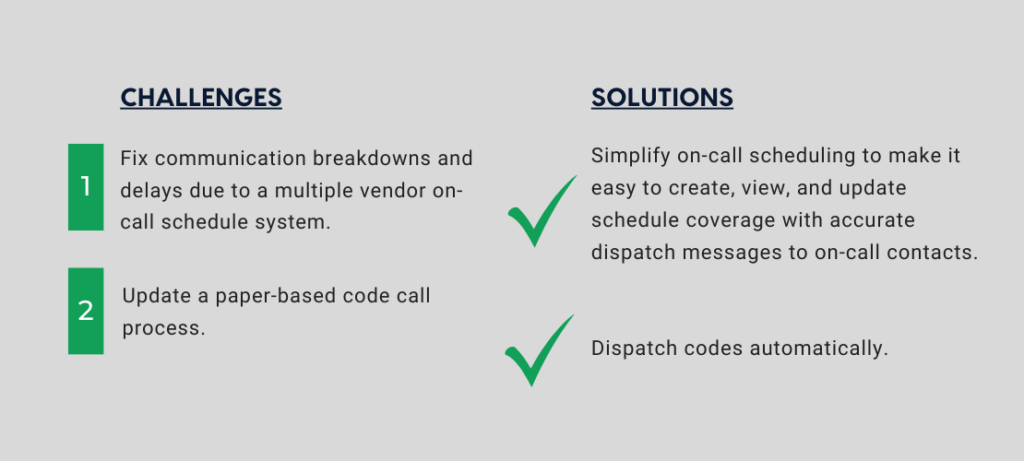Swedish Health Services was founded as Swedish Hospital in 1910 by an immigrant from Sweden named Dr. Nils August Johanson. Over the years, the campus expanded and merged with other health systems to become Swedish Health Services. It is the largest nonprofit health provider in the Seattle metropolitan area, with five hospital campuses, two ambulatory care centers, and a network of more than 100 primary-care and specialty clinics.
Swedish Health Services merged with Providence Health & Service, one of the largest health systems in the country, in 2022 after working together for ten years to provide comprehensive care across Western Washington state. The Sisters of Providence founded Providence Health & Services in 1859 as a nonprofit Catholic healthcare system. The health system expanded to include more than 50 hospitals, 800+ non-acute care facilities, and many assisted living facilities.
Their newly branded organization, Providence Swedish, provides an array of care throughout the Puget Sound region. Their system of eight hospitals and 244 clinics employs more than 2,200 providers and 22,000 caregivers. Providence Swedish delivers the most comprehensive healthcare service in Western Washington, providing care for 1.2 million unique patients annually.
Identifying Healthcare Communication Inefficiencies
Providence Swedish is committed to protecting its patients and has a rigorous quality and patient safety program. Staff submits a “Quality Variance” to their supervisors if an unexpected incident or event occurs that is inconsistent with the organization’s standards. This process results in service reports internally known as eQVR.
This dedication resulted in the First Hill and Cherry Hill campuses earning the highest hospital safety grade of A in 2022 from the Leapfrog Group in their biannual Leapfrog Patient Safety Survey. These campuses were recognized for success in protecting patients from harm and error.

Research indicates that poor communication among healthcare professionals is a leading cause of patient harm. In one study that examined healthcare communication flows, Improving Patient Safety Through Provider Communication Strategy Enhancements, researchers cited that time spent searching for and contacting appropriate providers (a.k.a. “problematic time”) was a crucial communication issue. “As data collection progressed, it became apparent that ‘communication events’ were complex and included time spent ‘hunting and gathering’ for the correct information related to whom to call, how to best contact them, and what to do when the primary person was not available. On average, ‘problematic time’ consisted of 10 to 40 percent of total communication time…”
The study’s results found that taking action to enhance teamwork and communication is crucial in preventing unfavorable patient outcomes. Taking action is exactly how leaders from Providence Swedish responded when they identified a communication weakness in their on-call system.
Supervisors at Providence Swedish noticed an uptick in eQVRs related to nighttime on-call providers failing to return calls or pages about patients. The eQVRs were escalated up the chain of command. It was discovered that communication breakdowns and delays were happening due to how updated on-call schedules were handled by the on-call system.
“We had situations where a provider may have a last-minute schedule change, an after-hours availability update, or needed to change their preferred method of being contacted,” said Brenda Frieboes, On-Call Manager for Providence Swedish. “The previous process for communicating those changes was for the providers to contact the call center and inform an operator. However, the only thing a hospital operator could do at the time was to take a message and put it in their ‘notes of the day’ system. There wasn’t a way for a general announcement to go out. That meant a nurse on the floor wouldn’t know about a schedule change unless they happen to contact the call center looking for help because they couldn’t reach a provider.”
Improving On-Call Communication and Response
Elizabeth Wako, M.D., chief executive for Swedish Seattle, initiated the process of searching for a new on-call scheduling platform. She tapped the call center manager at Providence Swedish to find an advanced on-call scheduling system that could handle the roughly 200 schedules that needed to be managed.
Brenda explained, “We had our on-call schedules in several different scheduling platforms from three vendors. The web program we used hosted every link for every schedule, both for the landing page and for the schedules themselves.”

The team needed an accurate on-call scheduling solution that made it easy to create, view, and update schedule coverage with the ability to easily dispatch messages to on-call contacts using their preferred method of communication. Brenda said, “We literally called around to different hospitals to see what system they used, and we became aware of Amtelco.”
Amtelco’s on-call scheduling solution offered many benefits, including several that addressed the needs of the team, including:
- Advanced notifications about unfilled schedules.
- The ability for departments and clinics to enter and update their own schedules and add them to personal and mobile calendars.
- Automated, real-time updates.
Staff who needed remote access to their schedule could do so via the internet using the miTeamWeb application to:
- Access and view their on-call assignments and assign or request their own on-call assignments.
- Swap shifts with one another.
- Display information about on-call assignments for selected roles.
Enhancing Patient Safety with a Frictionless Code Call System
When the call center team at Providence Swedish began the process of finding a new on-call scheduling system, they also decided to update their hospital phone operator console with a more robust platform that could better handle the roughly 2,500 calls they receive each day and to improve the code call process. Brenda explained, “Providence Swedish has many different locations, and our hospital operators had to manually process code calls from each location using code sheets. For example, if someone from our Cherry Hill campus called a code stroke, operators had to write down the information, pull a Cherry Hill stroke form specific to their campus versus one from another site, and then call the code. There were about 100 different code sheets for all our campuses. Depending on the code, this manual process could take up to two minutes each. We needed a system that could dispatch codes automatically.”
Providence Swedish wanted an operator console that could work enterprise-wide to guide agents through code calls and quickly dispatch to the correct location with a system that also tied into the on-call software. “Our team chose Amtelco’s Soft Agent operator console,” said Brenda. “We use Soft Agent and Amtelco’s widget-based miTeamWeb app to manage on-call schedules because they can speak to each other. The codes are now dispatched through the system which met all our needs.”
“Now when a code call comes in it rings to an available operator, they select which campus, the code, and input any additional info needed into the fields to make the overhead announcement. It’s ‘click, click, click’ and they’re done. We dispatch between 1,000-1,200 codes a month from all eight of our hospitals, and most of our codes are dispatched in under a minute now. Dispatching our codes through Soft Agent versus pulling the code sheet has significantly decreased the number of serious safety events.”
Brenda Frieboes, On-Call Manager for Providence Swedish
The scripting component of Amtelco’s operator console is fully customizable to efficiently guide operators through any type of call, including complex code calls. Scripts are pre-programmed into the call center software to ensure agents ask pertinent questions, provide the right answers, and direct calls to the appropriate person, department, or campus. Once the scripts have been programmed into the system, the call center agents simply read the prompts and follow the script.
Code calls can be incredibly stressful, and accuracy and speed are critical. Amtelco’s healthcare-specific console system along with the miTeamWeb app helps to:
- Reduce operator errors.
- Improve efficiency for a better patient experience and outcome.
- Contact the correct on-call personnel.
- Provide detailed reporting analytics.
“Now when a code call comes in it rings to an available operator, they select which campus, the code, and input any additional info needed into the fields to make the overhead announcement. It’s ‘click, click, click’ and they’re done. We dispatch between 1,000-1,200 codes a month from all eight of our hospitals, and most of our codes are dispatched in under a minute now. Dispatching our codes through Soft Agent versus pulling the code sheet has significantly decreased the number of serious safety events,” said Brenda.
There are plans to introduce more automation and take advantage of miTeamWeb’s interoperable capabilities. Currently, if a code STEMI comes through, the operator must navigate to the on-call schedule page to find and contact the on-call doctor. Soon, when the Cardiology schedules are fully rolled over to miTeamWeb, and the operators dispatch a code STEMI, the system will automatically pull the STEMI doctor’s name, contact information, and notify that provider.
“We’re also working with the neuro-hospitalist team to complete an integration with miTeamWeb and a notification application used in the ED,” continued Brenda. “When a code stroke or code STEMI occurs, AMR (American Medical Response) calls from the field to notify the emergency department that they are bringing in a patient who is having a stroke. That sends a notification to the call center about a code stroke coming in. Currently, if our call center doesn’t hear from the ED within five minutes to initiate a code, an operator calls the ER to ask if a code stroke should be initiated. In this situation, time is obviously of the essence. We want to improve that process by using the information from the ED application to automatically notify the appropriate teams if there’s a code stroke that requires intervention.”
Implementing and Using the New Systems
Coordinating and implementing new software can be challenging for a system as large as Providence Swedish. While the hospitals will update their on-call scheduling platform to miTeamWeb, hospitalist groups, and other departments can decide to keep their current system. The entire organization is closely watching the project to see how it’s done and how successful it proves to be.
Brenda and her team began with a pilot group to train and roll over their schedules to the miTeamWeb system. The providers, caregivers, nurses, and technicians who were involved all got 24-hour access to their schedules via a QR code they scanned. When other departments saw the results and how easy it was to use, they were also interested in miTeamWeb. “Nuclear medicine and others wanted their schedule online too. So, I’ve built quite a few new schedules for groups and departments who didn’t have online schedules before,” said Brenda.
“To be able to sit down and look at it, and then figure out how to do something with a program you’re not familiar with within a few minutes – if that isn’t user-friendly, I don’t know what is”
Brenda Frieboes, On-Call Manager for Providence Swedish
Providence Swedish also has groups from a polyclinic with Kaiser Permanente Washington that admit patients to Providence Swedish hospitals. In the past, Providence Swedish providers would call Kaiser Permanente and speak with a polyclinic operator. The agent would connect the doctor from Providence Swedish and the doctor from Kaiser Permanente for a patient consult. These extra steps occurred because Providence Swedish operators could not access the polyclinic’s on-call schedules. Now the Kaiser polyclinic staff have their schedules online, making it much easier to find the information they need via miTeamWeb.
Brenda stated, “More schedules than ever before are coming online and are easier to access. Plus, it’s direct access to the providers instead of going through an answering service or another switchboard. This is one of the huge benefits of the on-call schedules. I can build as many as I need with as many shifts listed per day as needed. The hospital schedules 40 shifts a day. There’s not really an end to what we can do or who we can accommodate as far as an on-call schedule. We’re already seeing the benefits of this program.”
Change can be intimidating to staff who are used to doing things in a certain way. However, once new users try miTeamWeb, they report it’s surprisingly easy to use. “miTeamWeb is user-friendly,” said Brenda. “To be able to sit down and look at it, and then figure out how to do something with a program you’re not familiar with within a few minutes – if that isn’t user-friendly, I don’t know what is. When we were rolling out in the early stages, I had some difficulty getting the groups to enter their schedules for the next month into miTeamWeb. I’d send a reminder and promise it would only take them a few minutes to complete. Then, I’d suddenly receive a message back a half hour later saying it was so easy that they got the next three months done!”
Brenda continued, “It’s better compliance to have schedules completed promptly. Before miTeamWeb, I would have to look at every schedule the week before they were due, and I’d have to email staff about it and offer to post it for them. That scenario has dropped considerably and made my job a lot easier. Now, staff gets their schedules completed on time.”
Customizable, Flexible Communication Software for an Evolving Industry
The United States doesn’t have a uniform health system. This means each organization or even department within the same organization operates in its own unique way and has particular needs regarding technology.
Operating systems used by healthcare have to be customizable and flexible to meet the needs of an industry that is embracing new tools to modernize internal systems. “We’ve had a lot of asks of Amtelco, such as needing a customized single sign on process that our IT security wanted, the appearance of the on-call schedules, and tweaks to the software to make it work better for us,” said Brenda. “The Amtelco staff has always been very good at accommodating our requests or taking time to code something we need to work a certain way. I know that I can take any question, any ask to them, and it will be looked at and taken seriously.”
While health systems are trying to cut costs, they still must solve efficiency problems to address staff needs and better serve patients. Newly purchased technology should be an investment that can serve an organization with its present and future needs. “I personally wanted Amtelco’s operator console and miTeamWeb app. I was glad it met the hospital operator’s needs and was chosen,” said Brenda. “I fill in for the agents sometimes, and I liked it because it was a program that would grow with us. In 5-10 years, we won’t be doing this process again. We’re not going to be looking for a new on-call scheduling platform or a new operator console system because Amtelco will be able to meet our needs, as I see it, for the foreseeable future.”



